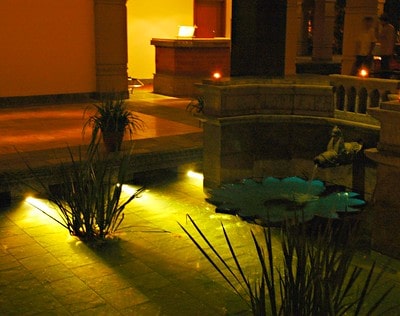You can light up a pond in a lot of different ways. You have to find the right balance by using the right lights in the right places.
If you don’t, you’ll end up with a pond that is hard to see or a beacon for planes that fly low. Also, you might end up with half the pond looking great while the other half is dark and murky. That’s why it’s important to plan carefully.
There are many ways to light up a pond. Hardwired lights don’t need you to charge batteries, but they are harder to set up. There are different places to put the lights, with edge and floating lights being the easiest to control. Downlights need a place to attach to, and lights that go underwater need a clean pond.
There is no single answer to what is the best way to light up a pond, so I’ll go over the different things to think about, such as:
- What kinds of lights are there?
- where you can put them in place
- How to light a Koi pond at its best

What Kinds of Pond Lights Are There?
Most pond lights will be low voltage because they don’t need to be high voltage and are much safer when running on 12 volts.
But some will run on batteries, and others will be plugged in. There are also other “kinds” of light to think about.
Hardwired vs. Battery-Powered Pond Lights
When choosing pond lights, one of the most important decisions is whether to use hardwired or battery-powered lights.
If you want lights that are hardwired, you will need a transformer because the lights are low voltage. If you connect them directly to the mains, they will get way too much power and break.
Putting in a transformer isn’t a big job. Once it’s set up, you can connect the lights to it. There are some things to think about when deciding how to bury the wiring, but the end result will be neat, and you’ll know that your lights will always work.
Battery-powered lights are much easier to set up, of course. There is no need for a transformer or wiring trenches.
But you have to charge that battery over and over again. Depending on the quality of the product and battery, the battery life could be anywhere from 10 to 50 hours on average.
So, once they are set up, hardwired lights will need less maintenance from you, but battery-powered lights are faster and easier to set up.
Solar lights for ponds
Solar lights are good because they don’t need to be hardwired and, in theory, don’t need to be charged by hand either.
On the surface of the pond, you can put solar lights that float or stake into the ground. They are usually not as bright as battery-powered lights and not as bright as lights that are hardwired.
But if your pond gets a lot of sun, they may be a good choice if you want to do as little work as possible.
Lights for Dusk Till Dawn Pond
Some lights, both those that run on batteries and those that are hardwired, have a light sensor that turns them on only when the amount of light in the room drops below a certain level. During the day, you don’t need your pond lights to be on, so these are a great way to save the battery.
Just remember that you shouldn’t leave your pond lights on all night if you have fish in it. They need to take a break. Make sure you can override the sensor and turn them off at night, so they only come on when it gets dark and you can still see your pond.
Where Should Pond Lights Be Put?
There are four main places around a pond where lights can be put. Each has its pros and cons, and you may prefer a mix of two or more of these rather than just sticking to one.
Submerged lights
Many pond lights are made to be put in below the water’s surface, either to light the whole pond or to light the way up. If you want to fully light up the water in your pond, these are by far the best choice.
They will let you see deep into your pond, while other lights will lose their brightness once they hit the surface of the water. But that’s not always a good thing. For example, if your pond is cloudy and has a lot of moss, submerged lights will show that up.
There’s also a chance that moss will grow on the light and prevent it from working properly.
Also, submerged lights need the most care because they need to be cleaned and are most likely to break over time. If you
Floating Lights
On the surface of the water, there are lights that float. They can’t be hardwired, though, because you can’t run a wire along the surface of the pond (technically, you could, but it would look terrible).
They can be powered by a regular battery or by the sun. Solar lights aren’t as bright as regular lights, and you need a lot of sunlight to charge them.
Lights that float will shine into the water below and around them. But because they aren’t as strong as wired lights, they might not light up all the way to the edge of the pond.
You can add more than one light, but if you add too many, the lights will take over the look.
Edge Lights
Edge lights are made to go around the edge of a pond and point into the water.
People like these because they can be powered by batteries, solar panels, or wires, and you can put them anywhere you want.
Be careful about putting lights on stakes in the soft ground near the edge of the pond. The wet ground won’t hold the lights, and they could fall in.
It’s best to put them away from the edge of the pond or on stable ground, like a rockery, where they won’t move. They light up your pond well, both around the edges and on the water’s surface. They won’t go too deep into the water, though.
Downlights
Downlights are lights that shine down from high above the pond. They can be string lights or floodlights that shine in a certain area.
Because downlights are farther away from the pond, they tend to give off the most natural light, which looks like soft moonlight.
But putting them up is more difficult because you need anchor points. If trees are close to the pond, that’s best. If you don’t have your own points, you’ll need to get them first.
Floodlights have to be hardwired, but string lights can either be powered by the sun or by electricity.
How To Illuminate A Koi Pond?
If you have a Koi pond, you want to be able to see and enjoy your fish. But you should be careful.
Fish do react to pond lights. They like a regular day/night cycle, and the light and heat can bother them. LED lights don’t get too hot, but older types of bulbs do.
Fish also don’t like being out in the open, so lighting up your whole pond can make them feel uncomfortable.
Plus, you don’t want to show off your Koi to nearby predators or poachers since they are valuable fish.
If you want to light up a Koi pond, make sure there are places for the fish to hide. Use LEDs that don’t heat up the water, and make sure the lights are on a timer so your fish can get some rest.
Remarks
Every pond is different. They come in different sizes, shapes, and styles. So the way you light them up will depend a lot on your own pond.
But you have a lot of choices, like how to power them and where to put them so they look the best.
Most of the time, hardwired lights are better than solar lights, unless you always have enough sunlight to make solar lights worth it.
Battery-powered lights work well, but it can be a pain to change the batteries or charge them.
What kind of pond lights did you put in, and where did you put them?
